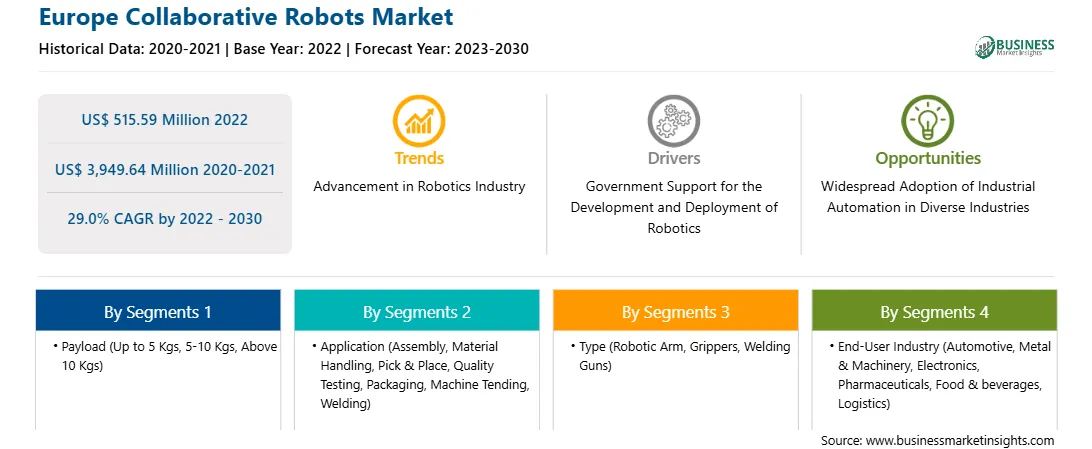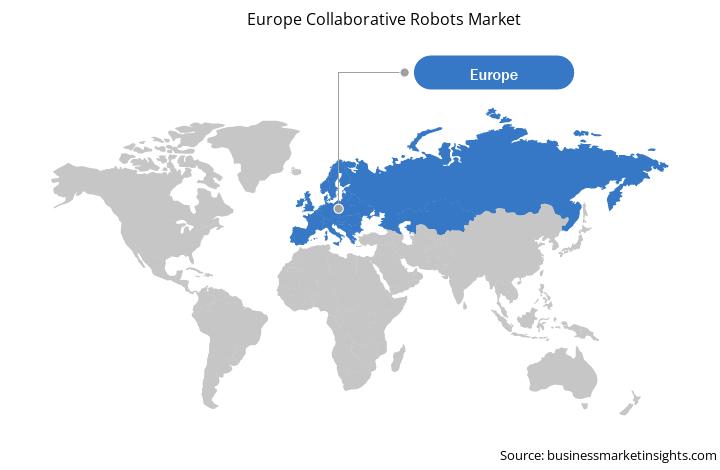The penetration of industrial automation is gaining pace in various industries other than automotive, such as logistics, food & beverages, electrical & electronics, and rubber & plastics, among others. In the recent past, the non-automotive industries were very underpenetrated in comparison to the automotive industry. With the increasing functionality of equipment such as collaborative robots, it is anticipated that the non-automotive industries will further accelerate the adoption of collaborative robots. Apart from industries, the penetration is also increasing among countries. The prospective for further robot installations is remarkable in many of these countries, particularly in the automotive industry. This growth is attributed to the necessary modernization and transformation required in these markets. These statistics are promising for collaborative robots manufacturers as it signifies the huge scope for further increase in adoption. It is expected that the low penetration will propel considerable growth during the forecast period if there is a considerable support from the government to the manufacturers.
The European region comprises of several major manufacturing industries such as aerospace, machinery & equipment, automotive, ship building, military vehicles, and others. The Automotive industry of the EU is a crucial industry as it significantly contributes to the country's GDP (6.8%) as well as provides employment to millions of people in the region. EU is the leading producer of motor vehicles and several premium automotive manufacturers are based in the region. Furthermore, the automotive sector of the region represents the largest private investor in R&D as well as it receives support from the government such as funds for R&D. Vehicle Manufacturing Industry is a strategic industry, which produces around 19.2 million cars, vans, buses, and trucks per year. Moreover, around 300 vehicle assembly and manufacturing facilities are in around 26 countries across the region. According to ACEA, 21% of the cars cross the world are manufactured in EU with companies such as BMW, Volkswagen, Audi, and Aston Martin. Germany is the largest contributor in the automotive market share of the region, accounting for over 29% share. The country comprises of major car manufacturers such as VW, BMW, Opel, Daimler AG, and Audi, among others. On an average, Germany produces over 6 million passengers as well as commercial vehicles every year. The robust automobile sector of the region along with the presence of major premium car manufacturers in EU is anticipated to drive the Europe Collaborative Robots Market. Further, the growth of electric vehicle manufacturing is also anticipated to drive the market growth. Further, a project named as 'VALERI', "Validation of Advanced, Collaborative Robots for Industrial Applications" that is coordinated by the Fraunhofer Institute for Factory Operation and Automation (IFF) in Germany along with industrial partners, FACC, IDPSA, Airbus DS, and KUKA Laboratories GmbH, as well as research partners PRODINTEC and Profactor GmbH; is supporting adoption of collaborative robots.
The Europe collaborative robots market is segmented into payload, application, type, end-user industry, and country.
Based on payload, the Europe collaborative robots market is segmented into up to 5 Kgs, 5-10 Kgs, and above 10 Kgs. The above 10 Kgs segment held the largest share of the Europe collaborative robots market in 2022.
In terms of application, the Europe collaborative robots market is segmented into assembly, material handling, pick & place, quality testing, packaging, machine tending, welding, and others. The assembly segment held the largest share of the Europe collaborative robots market in 2022.
Based on type, the Europe collaborative robots market is segmented into robotic arm, grippers, welding guns, and others. The robotic arm segment held largest share of Europe collaborative robots market in 2022.
In terms of end user industry, the Europe collaborative robots market is automotive, metal & machinery, electronics, pharmaceuticals, food & beverages, logistics, and others. The automotive segment held largest share of Europe collaborative robots market in 2022.
By country, the Europe collaborative robots market is segmented into the Germany, France, Italy, the UK, Russia, Sweden, Belgium, the Netherlands, and the Rest of Europe. Germany dominated the Europe collaborative robots market in 2022.
Kuka AG, Yaskawa America Inc, Aubo (Beijing) Robotics Technology Co Ltd, Fanuc Corp, ABB Ltd, Universal Robots AS and Kawasaki Heavy Industries Ltd are some of the leading companies operating in the Europe collaborative robots market.
Strategic insights for the Europe Collaborative Robots provides data-driven analysis of the industry landscape, including current trends, key players, and regional nuances. These insights offer actionable recommendations, enabling readers to differentiate themselves from competitors by identifying untapped segments or developing unique value propositions. Leveraging data analytics, these insights help industry players anticipate the market shifts, whether investors, manufacturers, or other stakeholders. A future-oriented perspective is essential, helping stakeholders anticipate market shifts and position themselves for long-term success in this dynamic region. Ultimately, effective strategic insights empower readers to make informed decisions that drive profitability and achieve their business objectives within the market.

| Report Attribute | Details |
|---|---|
| Market size in 2022 | US$ 515.59 Million |
| Market Size by 2030 | US$ 3,949.64 Million |
| Global CAGR (2022 - 2030) | 29.0% |
| Historical Data | 2020-2021 |
| Forecast period | 2023-2030 |
| Segments Covered |
By Payload
|
| Regions and Countries Covered | Europe
|
| Market leaders and key company profiles |
The geographic scope of the Europe Collaborative Robots refers to the specific areas in which a business operates and competes. Understanding local distinctions, such as diverse consumer preferences (e.g., demand for specific plug types or battery backup durations), varying economic conditions, and regulatory environments, is crucial for tailoring strategies to specific markets. Businesses can expand their reach by identifying underserved areas or adapting their offerings to meet local demands. A clear market focus allows for more effective resource allocation, targeted marketing campaigns, and better positioning against local competitors, ultimately driving growth in those targeted areas.

The Europe Collaborative Robots Market is valued at US$ 515.59 Million in 2022, it is projected to reach US$ 3,949.64 Million by 2030.
As per our report Europe Collaborative Robots Market, the market size is valued at US$ 515.59 Million in 2022, projecting it to reach US$ 3,949.64 Million by 2030. This translates to a CAGR of approximately 29.0% during the forecast period.
The Europe Collaborative Robots Market report typically cover these key segments-
The historic period, base year, and forecast period can vary slightly depending on the specific market research report. However, for the Europe Collaborative Robots Market report:
The Europe Collaborative Robots Market is populated by several key players, each contributing to its growth and innovation. Some of the major players include:
The Europe Collaborative Robots Market report is valuable for diverse stakeholders, including:
Essentially, anyone involved in or considering involvement in the Europe Collaborative Robots Market value chain can benefit from the information contained in a comprehensive market report.